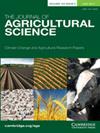抗草甘膦/草铵膦/2,4- d大豆对志愿玉米控制的增效和拮抗作用
IF 1.7
4区 农林科学
Q2 AGRICULTURE, MULTIDISCIPLINARY
引用次数: 1
摘要
来自抗草甘膦/草铵膦(GGR)志愿者玉米的杂草干扰会降低大豆的产量和质量。最近发布的抗草甘膦/草铵膦/2,4- d胆碱(GG2)大豆将允许扩大POST除草剂混合物的选择,用于广谱杂草控制。在包括志愿玉米在内的多种杂草中,已经证实了抑制性谷草除草剂和合成生长素除草剂之间的拮抗作用。研究人员于2021年和2022年在安大略省西南部进行了4项田间试验,以评估志愿者对抗gg2大豆使用草铵膦、2,4- d胆碱或麦草畏加氯噻虫胺或吡喹唑磷-乙酯复合施用后对玉米的控制效果。施用后6周,Quizalofop-p-ethyl和Quizalofop-p-ethyl +草铵膦控制的GGR志愿者玉米分别为95%和98% (WAA);在quizalofp -p-ethyl中加入2,4- d胆碱或麦草畏,将对照降低到≤15%。Clethodim对GGR志愿者玉米的控制率为81%,添加草铵膦使控制率提高到97%;在6 WAA时,2,4- d胆碱或麦草畏与氯虫啶共同施用可将志愿玉米的GGR控制分别降低至58%和45%。accase抑制除草剂与草铵膦共同施用对GGR志愿玉米的控制有增效作用,而与合成生长素除草剂共同施用对GGR志愿玉米的控制有拮抗作用。合成的生长素类除草剂与对乙基quizalofo -p-ethyl共施用时,拮抗作用比与clethodim共施用时更强。所有对乙基吡唑啉或噻虫啶与2,4- d或麦草畏的混合物都导致了对GGR志愿者玉米的不可接受的控制。本文章由计算机程序翻译,如有差异,请以英文原文为准。
Synergistic and Antagonistic Herbicide Interactions for Control of Volunteer Corn in Glyphosate/Glufosinate/2,4-D-Resistant Soybean
Weed interference from glyphosate/glufosinate-resistant (GGR) volunteer corn can reduce soybean yield and quality. The recent release of glyphosate/glufosinate/2,4-D choline (GG2)-resistant soybean will allow for expanded POST herbicide mixture options for broad-spectrum weed control. Herbicide antagonism between ACCase-inhibiting graminicides and synthetic auxin herbicides has been confirmed for various grass weed species, including volunteer corn. Field experiments (total of 4) were carried out in 2021 and 2022 in southwestern Ontario to assess volunteer corn control with combinations of glufosinate, 2,4-D choline, or dicamba plus clethodim or quizalofop-p-ethyl applied POST to GG2-resistant soybean. Quizalofop-p-ethyl and quizalofop-p-ethyl + glufosinate controlled GGR volunteer corn 95 and 98%, respectively, 6 weeks after application (WAA); adding 2,4-D choline or dicamba to quizalofop-p-ethyl reduced control to ≤ 15%. Clethodim controlled GGR volunteer corn 81%, and the addition of glufosinate increased control to 97%; the co-application of 2,4-D choline or dicamba with clethodim reduced GGR volunteer corn control to 58 and 45%, respectively at 6 WAA. ACCase-inhibiting herbicides co-applied with glufosinate resulted in a synergistic improvement in GGR volunteer corn control while co-applications with synthetic auxin herbicides resulted in an antagonistic decrease in GGR volunteer corn control. Greater antagonism occurred when the synthetic auxin herbicides were co-applied with quizalofop-p-ethyl than clethodim. All mixtures of quizalofop-p-ethyl or clethodim with 2,4-D or dicamba resulted in unacceptable control of GGR volunteer corn.
求助全文
通过发布文献求助,成功后即可免费获取论文全文。
去求助
来源期刊

Journal of Agricultural Science
农林科学-农业综合
CiteScore
2.80
自引率
5.00%
发文量
68
审稿时长
1.4 months
期刊介绍:
The Journal of Agricultural Science publishes papers concerned with the advance of agriculture and the use of land resources throughout the world. It publishes original scientific work related to strategic and applied studies in all aspects of agricultural science and exploited species, as well as reviews of scientific topics of current agricultural relevance. Specific topics of interest include (but are not confined to): all aspects of crop and animal physiology, modelling of crop and animal systems, the scientific underpinning of agronomy and husbandry, animal welfare and behaviour, soil science, plant and animal product quality, plant and animal nutrition, engineering solutions, decision support systems, land use, environmental impacts of agriculture and forestry, impacts of climate change, rural biodiversity, experimental design and statistical analysis, and the application of new analytical and study methods (including genetic diversity and molecular biology approaches). The journal also publishes book reviews and letters. Occasional themed issues are published which have recently included centenary reviews, wheat papers and modelling animal systems.
 求助内容:
求助内容: 应助结果提醒方式:
应助结果提醒方式:


